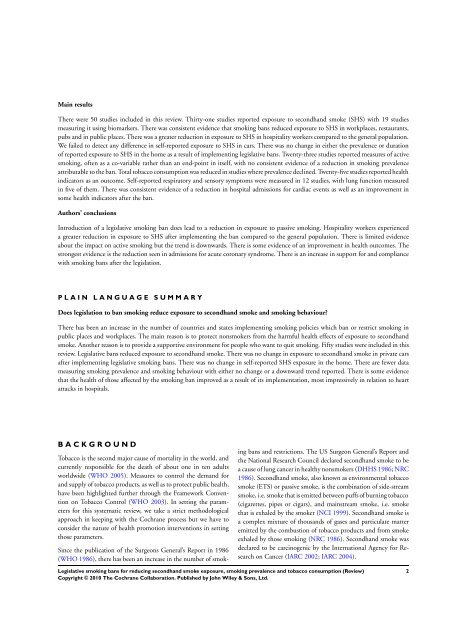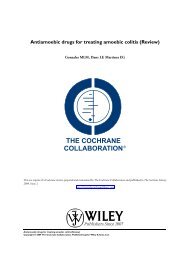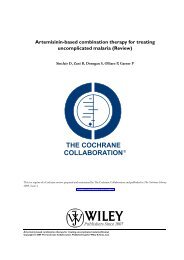Legislative smoking bans for reducing secondhand smoke exposure ...
Legislative smoking bans for reducing secondhand smoke exposure ...
Legislative smoking bans for reducing secondhand smoke exposure ...
Create successful ePaper yourself
Turn your PDF publications into a flip-book with our unique Google optimized e-Paper software.
Main results<br />
There were 50 studies included in this review. Thirty-one studies reported <strong>exposure</strong> to <strong>secondhand</strong> <strong>smoke</strong> (SHS) with 19 studies<br />
measuring it using biomarkers. There was consistent evidence that <strong>smoking</strong> <strong>bans</strong> reduced <strong>exposure</strong> to SHS in workplaces, restaurants,<br />
pubs and in public places. There was a greater reduction in <strong>exposure</strong> to SHS in hospitality workers compared to the general population.<br />
We failed to detect any difference in self-reported <strong>exposure</strong> to SHS in cars. There was no change in either the prevalence or duration<br />
of reported <strong>exposure</strong> to SHS in the home as a result of implementing legislative <strong>bans</strong>. Twenty-three studies reported measures of active<br />
<strong>smoking</strong>, often as a co-variable rather than an end-point in itself, with no consistent evidence of a reduction in <strong>smoking</strong> prevalence<br />
attributable to the ban. Total tobacco consumption was reduced in studies where prevalence declined. Twenty-five studies reported health<br />
indicators as an outcome. Self-reported respiratory and sensory symptoms were measured in 12 studies, with lung function measured<br />
in five of them. There was consistent evidence of a reduction in hospital admissions <strong>for</strong> cardiac events as well as an improvement in<br />
some health indicators after the ban.<br />
Authors’ conclusions<br />
Introduction of a legislative <strong>smoking</strong> ban does lead to a reduction in <strong>exposure</strong> to passive <strong>smoking</strong>. Hospitality workers experienced<br />
a greater reduction in <strong>exposure</strong> to SHS after implementing the ban compared to the general population. There is limited evidence<br />
about the impact on active <strong>smoking</strong> but the trend is downwards. There is some evidence of an improvement in health outcomes. The<br />
strongest evidence is the reduction seen in admissions <strong>for</strong> acute coronary syndrome. There is an increase in support <strong>for</strong> and compliance<br />
with <strong>smoking</strong> <strong>bans</strong> after the legislation.<br />
P L A I N L A N G U A G E S U M M A R Y<br />
Does legislation to ban <strong>smoking</strong> reduce <strong>exposure</strong> to <strong>secondhand</strong> <strong>smoke</strong> and <strong>smoking</strong> behaviour?<br />
There has been an increase in the number of countries and states implementing <strong>smoking</strong> policies which ban or restrict <strong>smoking</strong> in<br />
public places and workplaces. The main reason is to protect non<strong>smoke</strong>rs from the harmful health effects of <strong>exposure</strong> to <strong>secondhand</strong><br />
<strong>smoke</strong>. Another reason is to provide a supportive environment <strong>for</strong> people who want to quit <strong>smoking</strong>. Fifty studies were included in this<br />
review. <strong>Legislative</strong> <strong>bans</strong> reduced <strong>exposure</strong> to <strong>secondhand</strong> <strong>smoke</strong>. There was no change in <strong>exposure</strong> to <strong>secondhand</strong> <strong>smoke</strong> in private cars<br />
after implementing legislative <strong>smoking</strong> <strong>bans</strong>. There was no change in self-reported SHS <strong>exposure</strong> in the home. There are fewer data<br />
measuring <strong>smoking</strong> prevalence and <strong>smoking</strong> behaviour with either no change or a downward trend reported. There is some evidence<br />
that the health of those affected by the <strong>smoking</strong> ban improved as a result of its implementation, most impressively in relation to heart<br />
attacks in hospitals.<br />
B A C K G R O U N D<br />
Tobacco is the second major cause of mortality in the world, and<br />
currently responsible <strong>for</strong> the death of about one in ten adults<br />
worldwide (WHO 2005). Measures to control the demand <strong>for</strong><br />
and supply of tobacco products, as well as to protect public health,<br />
have been highlighted further through the Framework Convention<br />
on Tobacco Control (WHO 2003). In setting the parameters<br />
<strong>for</strong> this systematic review, we take a strict methodological<br />
approach in keeping with the Cochrane process but we have to<br />
consider the nature of health promotion interventions in setting<br />
those parameters.<br />
Since the publication of the Surgeons General’s Report in 1986<br />
(WHO 1986), there has been an increase in the number of smok-<br />
ing <strong>bans</strong> and restrictions. The US Surgeon General’s Report and<br />
the National Research Council declared <strong>secondhand</strong> <strong>smoke</strong> to be<br />
a cause of lung cancer in healthy non<strong>smoke</strong>rs (DHHS 1986; NRC<br />
1986). Secondhand <strong>smoke</strong>, also known as environmental tobacco<br />
<strong>smoke</strong> (ETS) or passive <strong>smoke</strong>, is the combination of side-stream<br />
<strong>smoke</strong>, i.e. <strong>smoke</strong> that is emitted between puffs of burning tobacco<br />
(cigarettes, pipes or cigars), and mainstream <strong>smoke</strong>, i.e. <strong>smoke</strong><br />
that is exhaled by the <strong>smoke</strong>r (NCI 1999). Secondhand <strong>smoke</strong> is<br />
a complex mixture of thousands of gases and particulate matter<br />
emitted by the combustion of tobacco products and from <strong>smoke</strong><br />
exhaled by those <strong>smoking</strong> (NRC 1986). Secondhand <strong>smoke</strong> was<br />
declared to be carcinogenic by the International Agency <strong>for</strong> Research<br />
on Cancer (IARC 2002; IARC 2004).<br />
<strong>Legislative</strong> <strong>smoking</strong> <strong>bans</strong> <strong>for</strong> <strong>reducing</strong> <strong>secondhand</strong> <strong>smoke</strong> <strong>exposure</strong>, <strong>smoking</strong> prevalence and tobacco consumption (Review)<br />
Copyright © 2010 The Cochrane Collaboration. Published by John Wiley & Sons, Ltd.<br />
2








